
Knutsford is a market town in Cheshire, England, 14 miles southwest of Manchester, 9 miles northwest of Macclesfield and 12+1⁄2 miles southeast of Warrington. The population at the 2011 Census was 13,191.
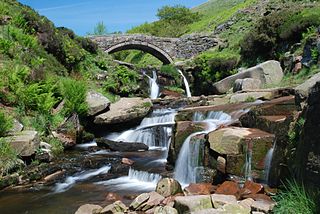
The River Dane is a tributary of the River Weaver that originates in the Peak District area of England. The name of the river is probably from the Old Welsh dafn, meaning a "drop or trickle", implying a slow-moving river.

Macclesfield is a market town and civil parish in the unitary authority of Cheshire East in Cheshire, England. It is located on the River Bollin in the east of the county, on the edge of the Cheshire Plain, with Macclesfield Forest to its east; it is 16 miles (26 km) south of Manchester and 38 miles (61 km) east of Chester.

Poynton is a town in Cheshire, England, on the easternmost fringe of the Cheshire Plain, 11 miles (18 km) south-east of Manchester, 7 miles (11 km) north of Macclesfield and 5 miles (8 km) south of Stockport. Poynton has formed part of the Cheshire East unitary authority since the abolition of the Borough of Macclesfield in 2009.
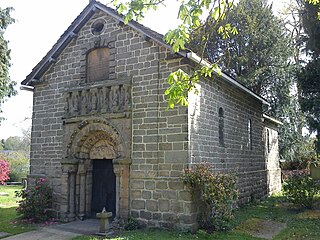
Prestbury is a village and civil parish in Cheshire, England, about 1.5 miles (3 km) north of Macclesfield. At the 2001 census, it had a population of 3,324; it increased slightly to 3,471 at the 2011 census. Alongside fellow "Cheshire Golden Triangle" villages, Wilmslow and Alderley Edge, it is one of the more sought-after places in the north. The ecclesiastical parish is almost the same as the former Prestbury local government ward which consisted of the civil parishes of Prestbury, Adlington and Mottram St Andrew.

Stockport Town Hall is a building in Stockport, England, that houses the government and administrative functions of Stockport Metropolitan Borough Council. Stockport Town Hall is a Grade II* listed building.

St James' Church is in the village of Gawsworth, Cheshire, England, and is sited near Gawsworth Hall. It is recorded in the National Heritage List for England as a designated Grade I listed building. It is an active Anglican parish church in the diocese of Chester, the archdeaconry of Macclesfield and the deanery of Macclesfield. Clifton-Taylor includes it in his list of 'best' English parish churches. The authors of the Buildings of England series describe the church as being "pretty, but odd".
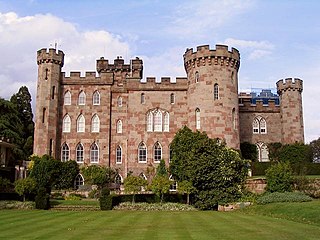
Cholmondeley is a civil parish in Cheshire, England, north east of Malpas and west of Nantwich. It includes the small settlements of Croxton Green and Dowse Green, with a total population of a little over a hundred, increasing to 157 at the 2011 Census. Nearby villages include Bickerton to the north east, Bulkeley to the north, Chorley to the east, No Man's Heath to the south west, and Bickley Moss to the south.
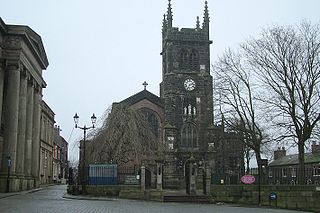
St Michael and All Angels Church overlooks Market Place in the town of Macclesfield, Cheshire, England. It is an active Anglican parish church in the diocese of Chester, the archdeaconry of Macclesfield and the deanery of Macclesfield. It forms a team parish with three other Macclesfield churches: All Saints, St Peter's and St Barnabas'. The church is recorded in the National Heritage List for England as a designated Grade II* listed building.

King Edward Street Chapel, Macclesfield is in the town of Macclesfield, Cheshire, England. It is recorded in the National Heritage List for England as a designated Grade II* listed building.

The Church of St Mary the Virgin is in the village of Bowdon near Altrincham, Greater Manchester, England. It is recorded in the National Heritage List for England as a designated Grade II* listed building. It is an active Anglican parish church in the diocese of Chester, the archdeaconry of Macclesfield and the deanery of Bowdon.

St Michael and All Angels Church stands on Warhill overlooking the village of Mottram in Longdendale, Greater Manchester, England. The church is recorded in the National Heritage List for England as a designated Grade II* listed building. It is an active Anglican parish church in the diocese of Chester, the archdeaconry of Macclesfield and the deanery of Mottram.

St Alban's Church in Macclesfield, Cheshire, England, is a Roman Catholic parish church. The church is recorded in the National Heritage List for England as a designated Grade II* listed building. It was designed by A. W. N. Pugin and is described as a "church of exceptional interest among the works of this major architect".

Gawsworth New Hall is a country house in the village of Gawsworth, Cheshire, England. It is recorded in the National Heritage List for England as a designated Grade II* listed building.

Regent House and Warwick House together form a large timber-framed building, probably dating from the late 16th century, in Nantwich, Cheshire, England. Regent House occupies numbers 12 and 14, and Warwick House numbers 16 and 18a, on the west side of the High Street ; Regent House occupies a bend in the street which reflects the town's Norman castle. The building was probably constructed shortly after the fire of 1583. Regent House and Warwick House are listed separately at grade II.

Macclesfield Sunday School is in Roe Street, Macclesfield, Cheshire, England. It started in 1796 as a non-denominational Sunday School in Pickford Street, which catered for 40 children. It was founded by John Whitaker whose objective was "to lessen the sum of human wretchedness by diffusing religious knowledge and useful learning among the lower classes of society". Though chapels set up their denominational schools, the Sunday School committee in 1812 elected to erect a purpose-built school on Roe Street. The Big Sunday School had 1,127 boys and 1,324 girls on its books when it opened. The building is now known as The Old Sunday School and is part of Macclesfield Museums.

Macclesfield Cenotaph is a World War I memorial in Park Green, Macclesfield, Cheshire, England. It was unveiled in 1921, and consists of a stone pillar and pedestal and three bronze statues. One statue is that of a mourning female, and the others comprise Britannia laying a wreath over a soldier who had died from gassing, an unusual subject for a war memorial at the time. The memorial is recorded in the National Heritage List for England as a designated Grade II* listed building.

The Memorial to John Whitaker is in Roe Street, Macclesfield, Cheshire, England. It stands in the forecourt of the Sunday School that Whitaker established in 1814, and was placed there in 1846 to commemorate the school's fiftieth anniversary. The memorial was sculpted by Alfred Gatley in stone and marble, and contains a bust of Whitaker in a medallion on the south face. The monument is recorded in the National Heritage List for England as a designated Grade II listed building.
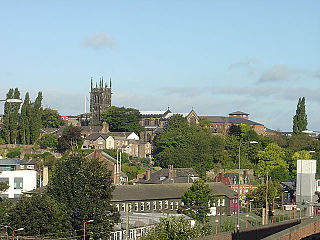
Macclesfield is a town in Cheshire East, England. It was originally a market town, and was granted a charter in 1261. The medieval town surrounded a hilltop that contained the Church of St Michael and the marketplace. Industry came to the town in the 18th century following the building of the first silk mill by Charles Roe in 1743. This industry grew with the building of more mills, and of houses incorporating weavers' garrets on the top floor, with large windows to light them. The mills were initially supplied with power from horses, or from the River Bollin, which ran through the town. Later, steam power was introduced. Communication was improved by the building of the Macclesfield Canal, which was completed in 1831. The silk industry declined from 1851, industry in the town diversified, and most of the surviving silk mills were converted into other industrial purposes or for domestic use. During the 20th century, some of the buildings were cleared from the town centre, and housing estates were built on the periphery of the town.
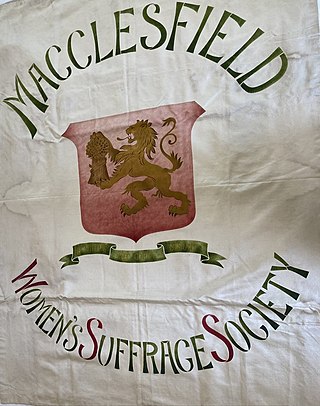
Macclesfield Museums is a collection of four museums focusing on Macclesfield and the Silk Industry. The museums are owned by Cheshire East, the local council, and managed on their behalf by the Macclesfield Silk Heritage Trust. The museums are called The Silk Museum, Paradise Mill, West Park Museum and The Old Sunday School.




















